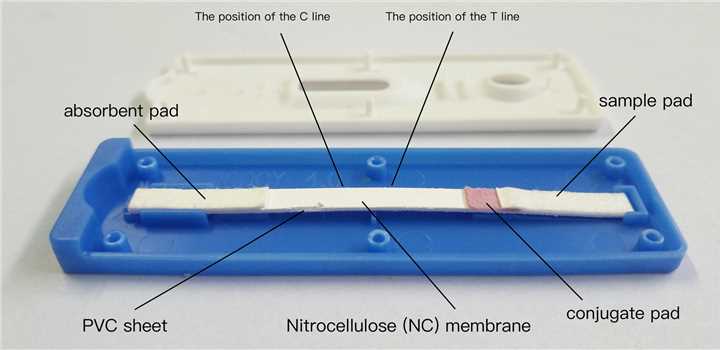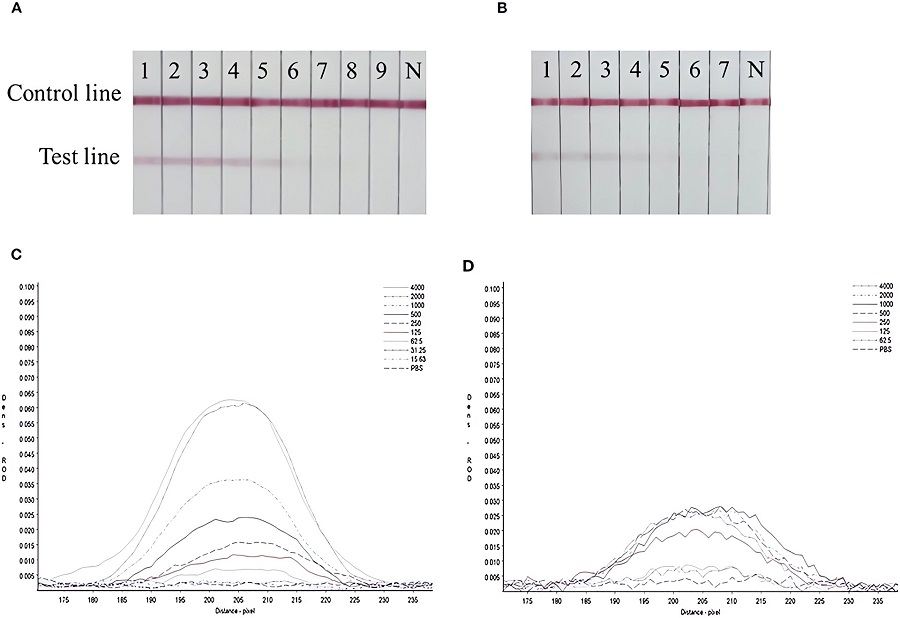Creative Biolabs is a world-class service provider in the in vitro diagnostics (IVD) industry who is skilled in the development of IVD assays. Supporting by an excellent scientific team and a well-established colloidal gold-based immunochromatographic assay platform, we support the best colloidal gold-based immunochromatographic assay development services for global clients to advance the development of a specific and accurate IVD assay.
Introduction of Colloidal Gold-based Lateral Immunochromatographic Assay
The colloidal gold-based immunochromatographic assay combines antigen-antibody immune reaction and colloidal gold labeling technology for qualitative and quantitative detection of antigen and antibody content. This assay has been widely used in the field of clinical diagnosis due to its multiple advantages such as rapidness, simplicity, low cost, and good stability. Although the sensitivity of this method is lower than that of PCR, this method is simple and convenient to operate and does not require special expensive reagents and equipment.
Types of Colloidal Gold-based Lateral Immunochromatographic Assay
The commonly used colloidal gold-based lateral immunochromatographic assay methods include double-antibody sandwich method, competition method, and indirect method. These methods have significant differences between principle and analytes.
1. Double-Antibody Sandwich Method
This method is mainly used to detect relatively large biomolecules and particulate antigens. It requires the preparation of the paired antibody of the analytes. One antibody is called coating antibodies which are labeled with colloidal gold and fixed on the conjugate pad. The other antibody is called capturing antibodies this is also fixed on the detection line of the nitrocellulose (NC) membrane. Besides, it is necessary to prepare a secondary antibody that specifically binds to the gold-labeled antibody and fix it on the control line of the NC membrane.
2. Competition Method
This method is suitable for the detection of small molecule antigens. In the competition method, the antibodies labeled with colloidal gold are fixed on the conjugate pad. The small molecule antigens to be tested are chemically coupled with BSA and other macromolecular substances and then fixed on the detection line of the NC membrane. It is also required to prepare a second antibody that can specifically bind to the gold-labeled antibody immobilized on the control line.
3. Indirect Method
This method is mainly used to detect antibodies. In an indirect method, Protein A that can bind to the antibody non-specifically is labeled with colloidal gold and then fixed on the conjugate pad. An antigen that can specifically bind to the antibody to be tested is fixed on the detection line of the NC membrane. An anti-protein A antibody is fixed on the control line of the NC membrane.
Colloidal Gold-Based Immunochromatographic Assay for Rapid Detection of Goose Parvovirus
Goose parvovirus (GPV), a small, non-enveloped, single-stranded DNA virus, is one of the most serious viral pathogens. GPV infections cause acute or subacute sepsis in 4-20 days old goslings characterized by high infectiousness and exudative inflammatory bowel disease. For this reason, it is necessary to develop a sensitive, rapid, and convenient diagnostic approach to detect GPV infections. Yu et al. (2018) developed a rapid immunochromatographic assay based on antibody colloidal gold nanoparticles specific to GPV to detect GPV in goose allantoic fluid and supernatant of tissue homogenate. In this assay, the coating antibody was produced by immunizing the BALB/c mice with purified GPV suspension, and the capture antibody was produced by immunizing the rabbits with recombinant VP3 protein. The colloidal gold was prepared by reducing gold salt with sodium citrate coupled with the coating antibody. Results showed this assay was a sensitive and accurate detection method for rapid detection of GPV, with a lower limit of ~1.2 μg/mL.
 Fig.1 Schematic diagram of test strip.1, 2
Fig.1 Schematic diagram of test strip.1, 2
Our Capabilities
Creative Biolabs is committed to offering a one-stop colloidal gold-based lateral immunochromatographic assay development service based on our rich experience and solid expertise knowledge in the IVD field. Our services include experimental scheme design, preparation of experimental materials, validation of sensitivity, specificity, and stability of the testing as well as large-scale sample detection.
 Fig.2 Workflow of development of colloidal gold-based immunochromatographic assay.
Fig.2 Workflow of development of colloidal gold-based immunochromatographic assay.
If you are interested in our services, please contact us to discuss your project and achieve more details. We are your reliable partner to develop novel specific IVD assays for disease diagnosis research.
Published Data
1. Development of a New Colloidal Gold-Based Immunochromatographic Strip for Specific Detection of SARS-CoV-2 Spike Protein
 Fig.3 Sensitivity evaluation of the rapid detective immunochromatographic strip.3,2
Fig.3 Sensitivity evaluation of the rapid detective immunochromatographic strip.3,2
In this study, researchers produced 16 monoclonal antibodies (McAbs) against SARS-CoV-2 by immunizing mice with the receptor binding domain (RBD) of the spike protein, which was expressed in Chinese hamster ovary (CHO) cells. Then they utilized two of these McAbs to develop a colloidal gold-based immunochromatographic strip for the detection of the SARS-CoV-2 spike protein, offering the potential for monitoring vaccine quality. The strip demonstrated high specificity, detecting only the SARS-CoV-2 spike protein, with no cross-reactivity to other coronaviruses like SARS-CoV, MERS-CoV, or influenza viruses. It successfully detected subunit vaccine in the lab, with a detection limit of 62.5 ng/mL for the spike protein within 15–30 minutes. This strip offers a reliable approach for assessing vaccine quality by measuring the spike protein antigen levels.
References
- Yu, Xianglong, et al. "Development of colloidal gold-based immunochromatographic assay for rapid detection of goose parvovirus." Frontiers in Microbiology 9 (2018): 953.
- Distributed under Open Access license CC BY 4.0, without modification.
- Li, Ge, et al. "Development of a colloidal gold-based immunochromatographic strip for rapid detection of severe acute respiratory syndrome coronavirus 2 spike protein." Frontiers in Immunology 12 (2021): 635677.
For Research Use Only.

